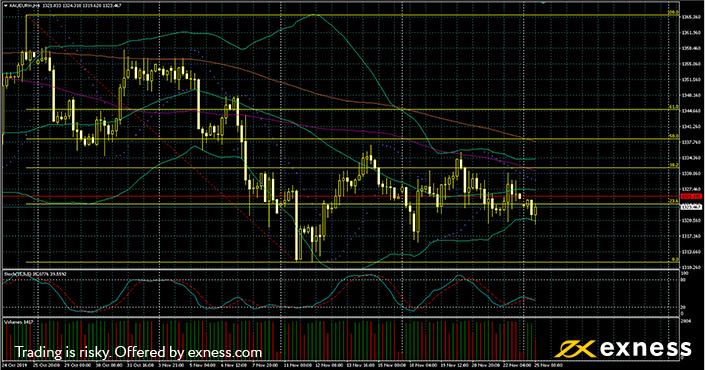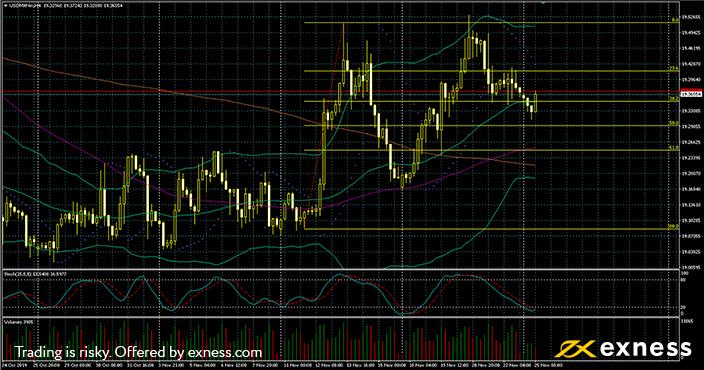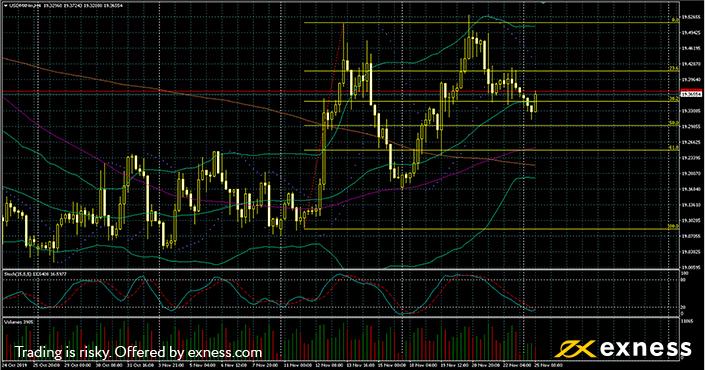The following article was submitted by Michael Stark, market analyst at Exness.
It was a fairly active start to the week for a number of instruments including the euro, gold, the peso and the pound. The focus of this week’s economic data is GDP in various countries, most notably the USA and Germany, but more abstract factors like trade wars and polling for the UK’s upcoming election will probably have a role to play in markets.
The only significant news from central banks last week was the People’s Bank of China’s decision to cut its loan prime rate by 0.05% to 4.15%. This hasn’t had much impact on USD-CNH, with the dollar holding fairly close to its recent highs on the four-hour chart.
This week’s main event among central banks is the Bank of Israel’s meeting on Monday afternoon. The current expectation is for a cut of the benchmark rate to 0.1% from the current 0.25%. Such a cut if it occurred would probably not have a major effect on USD-ILS, GBP-ILS etc; however, traders of these symbols should monitor the subsequent comments from the senior members of the BoI.
Gold-euro, four-hour
Gold has in general continued its downtrend against the euro since the end of October, mirroring more-or-less the picture for euro-dollar on the same timeframe. Generally better sentiment in stock markets and the dollar’s limited gains over the past few weeks have helped the euro make gains against the yellow metal.
The strongest area to the downside here appears to be the latest low a fortnight ago just above 1310. Price action around when this zone was first reached suggests that a bounce might be expected if the area is tested again. To the upside, the ‘value area’ between the 100 and 200 SMAs would be the first target for buyers. This is an important range because the two moving averages nearly overlap with the 50% and 38.2% Fibonacci retracement zones.
Key data points
- Tuesday, 26 November, 7.00 GMT – German GfK consumer confidence (December): consensus 9.6, previous 9.6
- Wednesday, 27 November, 13.30 GMT – American quarterly GDP growth (Q3, second estimate): consensus 1.9%, previous 2%
- Thursday, 28 November, 10.00 GMT – eurozone business confidence (November): consensus -0.15, previous -0.19
- Thursday, 28 November, 13.00 GMT – German annual inflation (November, preliminary): consensus 1.3%, previous 1.1%
- Friday, 29 November, 7.45 GMT – French quarterly GDP growth (Q3, final): consensus 0.3%, previous 0.3%
- Friday, 29 November, 10.55 GMT – German unemployment change (November): consensus 5,000, previous 6,000
Although less important than the German releases, traders should also consider Italian GDP growth and eurozone flash inflation on Friday morning.
Cable, four-hour
The pound has continued to be fairly volatile since last week as markets weigh up ever-changing polls and data from the UK. Last week ended with something of a bang as flash manufacturing and service PMI missed expectations, significantly so in the case of service PMI. 48.6 is the steepest contraction in British services since July 2016.
On Monday of this week though the CBI’s monthly survey of British retailers came in significantly better than expected. -3 was the result for November against the consensus expectation for -10.
The chart of the pound against the dollar also suggests that the pound is unlikely to extend its losses in the immediate future. An upward crossover of the slow stochastic on Monday morning came after a higher opening. The two main moving averages (100 and 200 SMAs) have closed their gap since last week, though the current zone is likely to be unreliable as a ‘value area’ given cable’s volatility in the runup to the election on 12 December.
Overall the most likely scenario is probably a consolidation around the current area ahead of American GDP data on Wednesday.
Key data points
- Wednesday, 27 November, 13.30 GMT – American quarterly GDP growth (Q3, second estimate): consensus 1.9%, previous 2%
- Wednesday, 27 November, 13.30 GMT – American durable goods orders (October): consensus -0.8%, previous -1.1%
- Friday, 29 November, 0.01 GMT – British GfK consumer confidence (November): consensus -14, previous -14
- Friday, 29 November, 9.30 GMT – British net lending to individuals (October): consensus £4.4 billion, previous £4.6 billion
Dollar-peso, four-hour
The dollar’s gains against the peso have slowed somewhat since last week. Today in particular saw some better (or at least less bad) data from Mexico. Annual GDP growth for Q3 was -0.3% against the consensus for -0.4% and the previous -0.9%. The quarterly figure at 0% was 0.1% worse than expectations but still better than the previous decline. Crude oil, usually seen as correlated with the peso, has made a small loss so far this week.
The technical picture continues to indicate that the bulls are in control here. Despite the inability of price to hold its new high in the middle of last week, the downward reaction afterwards was not nearly as significant as that the week before after the BdeM’s meeting. It also appears that the slow stochastic is about to produce a buy signal with an upward crossover in oversold. Finally, we can observe two golden crosses last week as both the 50 SMA (from Bands) and the 100 SMA moved about the slower brown line.
Wednesday’s a critically important day of data for this symbol, but traders still should not ignore the general news of trade wars. The peso remains fairly vulnerable to sudden intensifications of insults as well as actual tariffs between the USA and China.
Key data points
- Wednesday, 27 November, 13.00 GMT – Mexican unemployment rate (October): consensus 3.8%, previous 3.8%
- Wednesday, 27 November, 13.00 GMT – Mexican balance of trader (October): consensus -$1.8 billion, previous -$0.1 billion
- Wednesday, 27 November, 13.30 GMT – American quarterly GDP growth (Q3, second estimate): consensus 1.9%, previous 2%
- Wednesday, 27 November, 13.30 GMT – American durable goods orders (October): consensus -0.8%, previous -1.1%
- Wednesday, 27 November, 18.30 GMT – Banco de Mexico’s inflation report
- Thursday, 28 November, 15.00 GMT – minutes from the BdeM’s MPC
Dollar-Canadian dollar, four-hour
The Canadian dollar’s losses intensified somewhat last week as thousands of contractors for the Canadian National Railway went on strike after failing to reach an agreement with management. Canada is heavily reliant on rail transportation for most of its exports, so most traders as well as analysts expect that an extended strike will cause significant damage to the economy. Adding somewhat to the pressure on CAD was last Thursday’s weaker job data. ADP employment change showed a loss of 22,600 jobs against the expectation for 53,000 gains.
USD-CAD seems to be set for more gains over the next couple of days. Price remains above all three of the usual moving averages although it briefly tried to test the 50 SMA from Bands. The recent consolidation from strongly overbought conditions last Wednesday hasn’t resulted in a significant period of losses.
Key data points
- Wednesday, 27 November, 13.30 GMT – American quarterly GDP growth (Q3, second estimate): consensus 1.9%, previous 2%
- Wednesday, 27 November, 13.30 GMT – American durable goods orders (October): consensus -0.8%, previous -1.1%
- Thursday, 28 November, 13.30 GMT – Canadian current account (Q3): consensus -C$9 billion, previous -C$6.4 billion
- Friday 29 November, 13.30 GMT – Canadian GDP growth (annualised, Q3): consensus 1.3%, previous 3.7%
Disclaimer: any opinions made may be personal to the author and may not reflect the opinions of Exness or LeapRate.




